Before moving to South Korea in 2016, the extent of my Korean food knowledge was probably kimchi 김치, bulgogi 불고기, japchae 잡채, and KBBQ. *HELLA basic, right?* Luckily, there aren’t a lot of foods I hate, I ate school lunch while teaching, and I’m always down to try new foods.
It didn’t take me very long to start learning about all the scrumptious Korean foods I’d been missing out on. However, when I arrived there, I did NOT like spicy food. My tolerance for spiciness was almost zilch.
I stayed away from kimchi (also because I strongly disliked pickled foods) and anytime a food had a hint of spiciness, which was probably 70% of the time, I drank endless amounts of water or I ate a ton of rice. That last reason is probably why I gained a lot of weight my first year there too. *Korea freshmen 15, anyone?!*
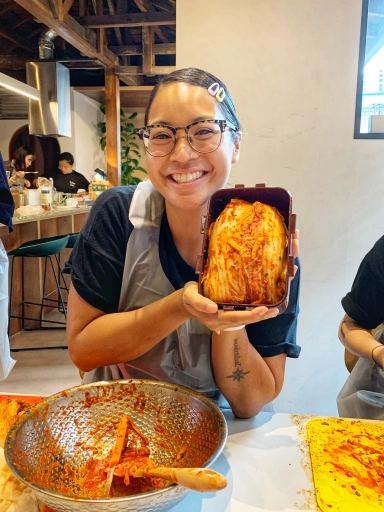
Today, I miss eating kimchi with almost every meal and I request my foods to be spicier than I used to – but still not THAT spicy. All because my BFF Ariel came to work at my school my third year there and challenged me to eat just ONE BITE of kimchi a day at lunch. Her plan worked, I love it now.
Because Korean food is definitely one of the things I most about South Korea – along with affordable healthcare, a coronavirus situation that’s under control, and people not being selfish for the safety of others *BIG SIDE EYES RN* – I decided to drop 10 must-try Korean foods!
These are foods that either I personally think you should try and/or ones my friends suggested, in no particular order. Read through the end for some honorable mentions & a couple of pro-tips about Korean food.
1. BBQ
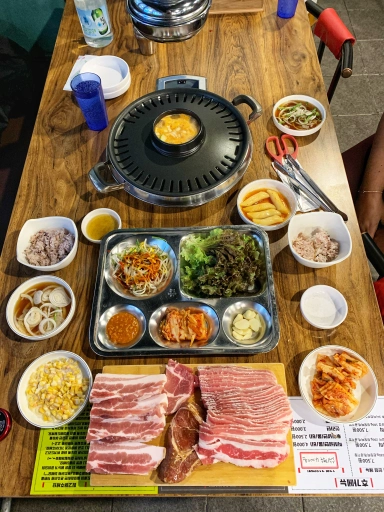
You might’ve had KBBQ wherever your home country is, but there’s nothing like KBBQ when you’re actually in South Korea. Although, it’s just called BBQ there. Korean barbecue – also known as gogigui 고기구이 (“gogi” being meat) – is probably the most famous Korean cuisine aside from kimchi.
Depending on what kind of meat I wanted and/or what kind of budget I was on, there were always infinite choices for BBQ. Restaurants usually offer either pork or beef, but many offer both. A few of my favorite spots were:
Samdawon 삼다 원 – a restaurant right in my apartment building in Bucheon (yess!) which serves pork from Jeju. We usually ordered ogyeopsal 오겹살 (five layered pork belly) and moksal 목살 (“neck meat”).
Palsaik Samgyeopsal 팔색삼겹살 – a chain in Seoul that offers 8 flavors of samgyeopsal 삼겹살 (pork belly). You can choose what you like, but the one time I went there we tried the platter with all flavors: ginseng, wine, pine leaves, garlic, herb, curry, miso paste, hot.
Hongppa Myeongdonga (Myeong-dong Branch) 홍빠명돈가 명동점 – a restaurant in one of the most popular tourist areas of Seoul. It’s not the highest quality meat, but for under $15 USD, you can have all-you-can-eat pork, chicken, and beef BBQ. A great spot if you’re limited on your time in South Korea and you’re already going to Myeong-dong.
2. Kimchi Jjigae 김치찌개
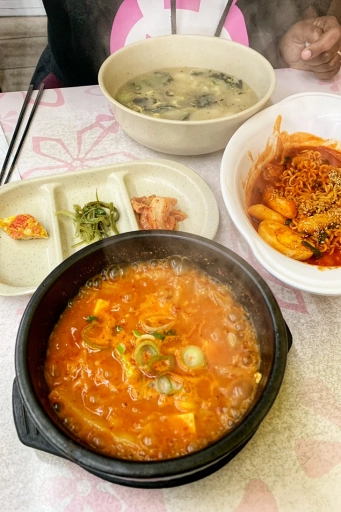
“Kimchi stew” is a classic! I won’t say it’s my favorite Korean dish *please don’t make me pick one!* but it’s up there. Kimchi, tofu, scallions, and onions are mixed with pork or seafood. My favorite is when it has samgyeopsal 삼겹살 (pork belly) or chamchi 참치 (tuna) – yes, from the can.
3. Doenjang Jjigae 된장찌개
A traditional soybean paste stew, this is a staple of everyday Korean meals. It’s usually served alongside banchan 반찬 (side dishes), especially when eating barbecue, and is meant for sharing. If you’re at a BBQ restaurant, it’s also usually refillable if provided along with the banchan.
4. Dak Galbi 닭갈비
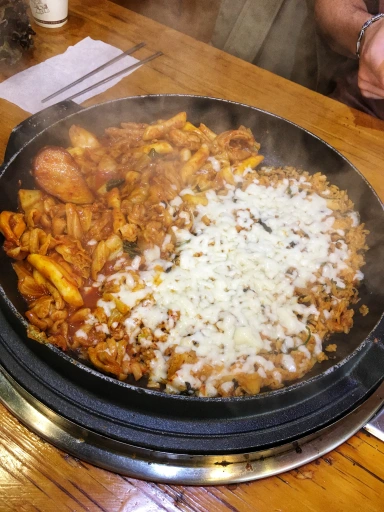
This is one of the foods I didn’t like when I first came to South Korea because it’s normally very spicy. As my spice tolerance grew, so did my love for dak galbi. This spicy marinated chicken is stir-fried in a large, round hot plate right at your table.
Other ingredients mixed-in normally include sweet potatoes, cabbage, scallions, and perilla leaves. I usually don’t like tteok 떡 (rice cakes) because of the texture but when it’s added into dak galbi and fried, I will eat it!
Usually eaten in bites wrapped in lettuce, do yourself a favor and when you’re about halfway through, ask for kimchi bokkeumbap 김치볶음밥 (kimchi fried rice) with cheese. GAME. CHANGER.
Though it’s marinated in a gochujang 고추장 (red chili paste) based sauce, a chain called Haneul Borndak had a flavorful curry dak galbi option instead. It was the preferred spot near my apartment to go for dak galbi until another chain, Dak Galbi Jejakso, opened close by and offered an all-you-can-eat option for a very affordable price. Then, I had options!
5. Chimaek 치맥
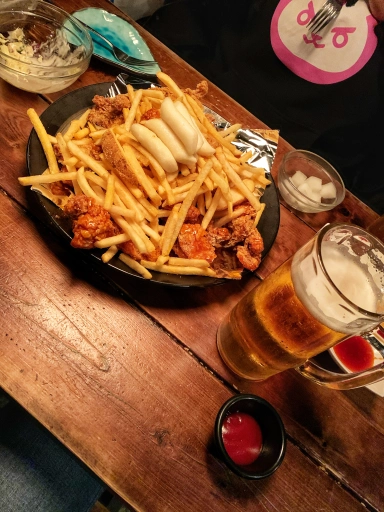
Korean fried chicken 후라이드 치킨 + maekju 맥주 (beer) = a match made in heaven. There are endless amounts of chicken places when it comes to having chimaek, but my favorite place to get it is a place called Outdark. It originated in Busan, and there was one really close to my apartment, but I never tried it until 3 months before I left. BIG REGRETS. *insert facepalm here*
Their chicken includes french fries + fried tteok (rice cakes), which are usually charged extra at other restaurants. The chicken is perfectly crispy on the outside and moist on the inside. You get dipping sauces on the side. And the beer is icy cold in clear icy mugs when it arrives at your table. *Are you drooling yet?*
The best flavors to get for chimaek are a mix of original and yangnyeom chicken 양념 치킨 (“seasoned chicken”) – or as my friend Shaniece likes to call it, “yum yum chicken.”
6. Hotteok 호떡
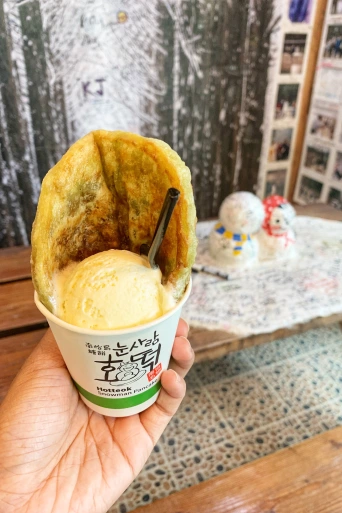
This beloved street food is a flat sweet-filled pancake fried on a griddle. Fillings usually consist of brown sugar, honey, cinnamon, peanuts and it usually won’t cost you more than 3,000 KRW.
In my opinion, it’s best had in winter when you find the hotteok truck/man for a hot treat after walking around in the cold. However, I did have hotteok with ice cream while visiting Nami Island last summer and IT. WAS. HEAVENLY.
7. Naengmyeon 냉면
Literally translated to “cold noodles,” the long, thin noodles are made from ingredients like buckwheat, potato, and sweet potato starch. You can find two types: mul naengmyeon 물냉면 and bibim naengmyeon 비빔냉면.
The first is prepared in a cold, clear beef broth or dongchimi 동치미 (radish kimchi water). Mul means water, which refers to the broth. The second type is served with gochujang 고추장 (red chili paste) as a dressing to be mixed in and usually comes with some broth on the side. Cold noodle soup might sound weird, but on a hot summer’s day, it’s quite refreshing – especially after having a meal sitting in front of a hot BBQ grill!
8. Bingsu 빙수
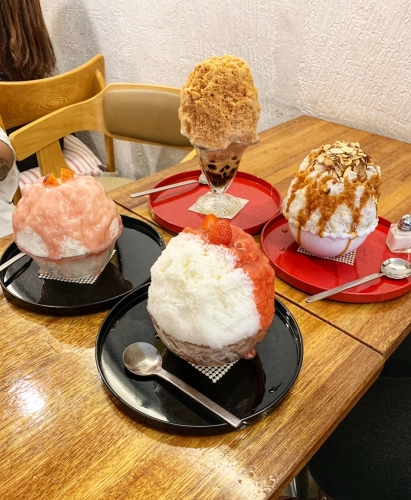
This well-known dessert is usually compared to Hawaii’s shave ice or The Philippines’ halo-halo. Its most basic form is pat bingsu 팥빙수 which consists of the ice, pat 팥 (red bean), and one or two other ingredients. I don’t like this version of it.
Fortunately, Koreans have become really creative with their bingsu and there are many varieties to choose from. Servings are usually large, so it’s best shared…or not.*You do you, boo!* Eat the whole thing if you want – those 4 servings up there were eaten by me and my 3 friends.
9. Jajangmyeon 자장면 / Jjajangmyeon 짜장면
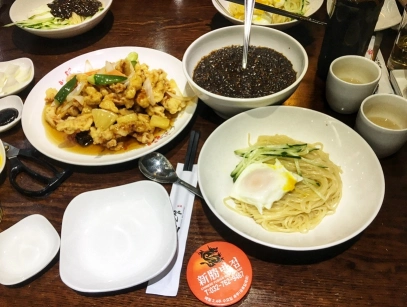
These noodles with black bean sauce are part of the widely loved Korean-Chinese cuisine. *Side note: did you know South Korea has its own Chinatown? It’s in Incheon.* Usually, they are eaten with a bowl of jjampong 짬뽕 (spicy seafood soup) and tangsuyuk 탕수육 (sweet and sour pork). Sometimes I prefer the rice version, jjajangbap 짜장밥.
10. Pizza 피자
Have you ever had corn on a pizza? Potato? Broccoli? Pasta? If you’re in South Korea, these are NOT hard to find as pizza toppings. In fact, it’s probably harder to find pizza as you regularly know it than it is to find corn on a pizza.
Seriously…when you order a cheese pizza, it’s highly likely that there won’t only be cheese on it but corn as well. Pizza School 피자스쿨 is a common chain that has really affordable pizzas (I’m talkin’ $5 USD/6,000KRW) that hella SLAP. It did take time to grow on me, but don’t knock it ‘til you try it, friends!
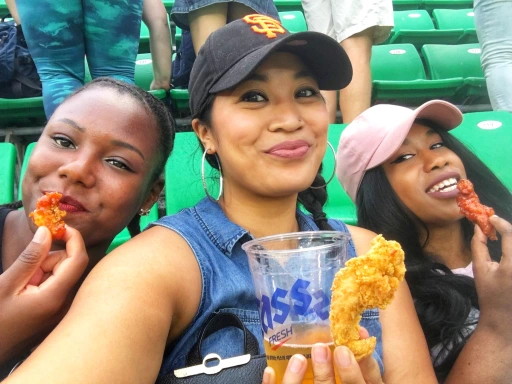
KOREAN FOOD Honorable Mentions
Here are more foods that didn’t make my list but were suggested by my oh-so-generous friends based on some of their faves: kongguksu 공국수, yukgaejang 육개장, haejangguk 해장국 aka “hangover soup,” pajeon 파전 and tteokbokki 떡볶이.
And if you’re feeling adventurous, a couple of popular foods that many tourists will try, but many others find weird are: sannakji 산낙지 (chopped raw baby octopus that is STILL MOVING) and meongge 멍게 (sea pineapple, usually eaten raw). I’ve eaten both – definitely “one time only” foods for me!
A Couple of Pro-Tips
Before I go, because I’m drooling while remembering all of these delicious foods, let me leave you with these two tidbits:
1) While South Korea has many delectable foods, and you may not think potatoes belong on a pizza (in certain circumstances, they DO!), here’s a warning for you courtesy of my friend, Katie: “Everything that has sugar on it – shouldn’t.”
You might think that’s extra salt on your garlic bread, street hotdogs, or fries but beware…those savory foods will be SWEET when you take that bite.
2) If you’re out eating BBQ (or any other meal, really) there will likely be soju. With chimaek, beer is guaranteed. But what if you don’t like one or the other?
Try somaek 소맥! Soju 소주 combined with maekju 맥주 (beer), it’s the perfect combination to take away some of that harshness of soju and the bitterness of the beer. It was my preferred Korean alcoholic drink by the time I left.
Now that I’ve made you hungry too, let me know which of these foods you’d love to try!
With wanderlust & ‘til next time,
Ava

